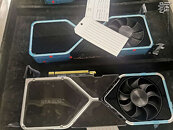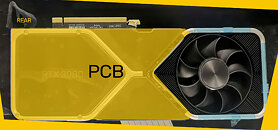Saturday, June 6th 2020

NVIDIA GeForce RTX 3080 Pictured?
Here are what could be the very first pictures of a reference NVIDIA GeForce RTX 3080 "Ampere" graphics card revealing an unusual board design, which is the biggest departure in NVIDIA's design schemes since the original GeForce TITAN. It features a dual-fan aluminium fin-stack cooler, except that one of its fans is located on the obverse side, and the other on the reverse side of the card. The PCB of the card appears to extend only two-thirds the length of the card, ending in an inward cutout, beyond which there's only an extension of the cooling solution. The cooler shroud, rather than being a solid covering of the heatsink, is made of aluminium heatsink ridges. All in all, a very unusual design, which NVIDIA could implement on its top-tier SKUs, such as the RTX 3080, RTX 3080 Ti, and in a cosmetic form on lower SKUs. We get the feeling that "Cyberpunk 2077" has influenced this design.
Sources:
ChipHell Forums, HXL (Twitter), VideoCardz



225 Comments on NVIDIA GeForce RTX 3080 Pictured?
The front airflow pattern seems legit. That fan will simply blow through the fins, as in a radiator.
There is absolutely no push-pull config here, as there is no such airpath...
Overall, I think the design is very functional-oriented and to me, it looks great. Fans on either side will probably help with airflow obstruction in some cases, and it may help with case/DIMM cooling. In some other cases (mostly smaller ones) however, the case airflow will get messed up.
I wish, for the sake of compatibility, they flipped that top fan to reverse the airflow direction, so that the card acts like all cards now do: intake only from under the card...
So the card definitely can/will intake from the back . Both fans present on the 2 different faces are intake fans !
Where i'm a little confused... with the 2 fans set on opposite sides doesn't that mean the pcb is downsized by roughly 50%? Is that even possible?
Axial / Radial
Also in case no one noticed there is almost no place for the die to be on board. You can't have the fan directly over the die as that would limit the area of the coldplate and heatpipes too much.
Most air coolers on GPUs are design such that the air goes through the fins around the fans not under them, because you can't fit many fins in there and there is also a dead spot under the fan.
SecondFirst picture if you look through the gap in the fan blades you can see another layer of fins that run length wise and not arrange in chevrons like the layer on top so the fans are shallow. Hence why the fans can't been seen through the other side and provides a path for air but that's from what I can see so I could be wrong.